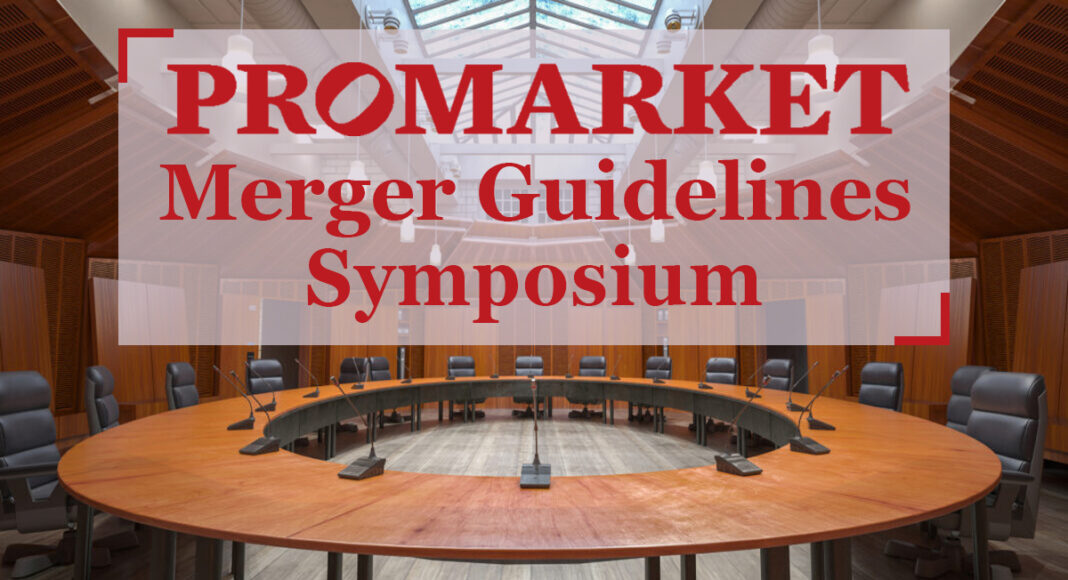Eric Posner provides his round-one comments on the draft Merger Guidelines.
To read more from the ProMarket Merger Guidelines Symposium, please see here.
Two years ago President Joe Biden issued with great fanfare an Executive Order on Promoting Competition in the American Economy that called for greater enforcement of the antitrust laws. He observed that the antitrust laws have been underenforced, resulting in more powerful corporations, higher prices, lower wages, and greater inequality. The two major antitrust agencies, the Department of Justice and the Federal Trade Commission, heeded his call by aggressively challenging high-profile mergers. But, though they gained some significant victories, again and again they have been thwarted by the courts.
Today may be a turning point as the two agencies issue a draft revision of their Merger Guidelines, the influential document that they first released to the public in 1968, and which has helped—for both good and for ill—to shape how the courts interpret merger law. Some might wonder how courts will receive the new Guidelines after a string of defeats. The answer is that the Guidelines will succeed only if the courts are willing to open their eyes to the new learning that they represent.
Section 7 of the Clayton Act of 1914 prohibits mergers whose effect “may be substantially to lessen competition or tend to create a monopoly.” The agencies typically challenge so-called horizontal mergers between competitors (e.g., Ford and GM), though they may try to block other kinds of mergers as well. A merger between competitors lessens competition virtually by definition; thus, the word “substantially” limits merger enforcement to “large” firms, which usually means at least one firm with, say, 30% of the market or more. The words “may be” direct courts to predict what will happen: mergers are typically challenged before they are consummated, so courts deal with “probabilities, not certainties.”
The major Supreme Court cases of the 1960s reflected longstanding congressional and public suspicion of corporate power. It was fine for corporations to grow large through innovation, but not by gorging themselves on their competitors or other firms that gave them technological or supply-chain advantages over their rivals. But soon the Court lost interest in merger law, and left the field to the agencies and the lower courts.
And then things went awry as the law was swallowed by that great fish, Economics. Some economists in the 1960s and 1970s believed that mergers were nearly always good. Mergers allowed firms to obtain efficiencies and cut costs. They disciplined managers. They diversified risk. And what economists saw as the main problem with monopolies—market power, or the ability to raise prices—seemed a tolerable and probably temporary inconvenience. By the 1980s, influential economists had persuaded the Justice Department that mergers should be allowed as long as the benefits exceeded the costs—meaning the cost savings (for the corporations) exceeded the harms (to the consumers), a rather startling interpretation of a Progressive-era statute. Whether or not Greed was good, Big definitely was good.
This extreme view yielded in the 1990s to a more moderate view that held that a merger should be allowed as long as it did not raise prices. But price predictions are hard, and merger litigation turned into a messy and expensive battle between economic models. The agencies became gun shy. The Obama-era 2010 Guidelines both raised the threshold for challenging mergers, and promised not to challenge even mergers that exceeded that threshold if they were not likely to raise prices in the view of agency economists.
Meanwhile, mergers continued apace and today there is growing evidence that the United States has a serious monopoly problem. During the long period of lax antitrust enforcement since the 1980s, firms have gotten bigger, markets more concentrated, and prices (or formally, “markups,” meaning the price above what would prevail in a competitive market) and corporate profits have steadily increased, while labor’s share of output has declined. Slack merger enforcement is not necessarily the cause of these trends, but it can’t have helped. Even business-friendly Republicans have noticed harms when competition fails. Social media giants can censor conservatives because they do not fear losing conservative customers to competitors, having no competitors to lose them to.
Economists have also rethought many of their premises. It turns out that the efficiencies thought to be the birthright of every merger are often mythical. Indeed, a huge fraction of mergers turn out to fail even without government intervention. The rise of platforms—and platform-platform mergers—has created new risks to market freedom. Mergers can harm workers as well as consumers. Economic methods for predicting the price impacts of mergers do not always work well and are difficult for judges to understand even when they do.
The new Guidelines (which I worked on during a year I spent in the Justice Department) address these problems by incorporating the latest economic wisdom and the agencies’ experience since 2010. They also take some straightforward steps, like strengthening the HHI thresholds for challenging mergers to what they were in the 1980s, and reminding businesses that the legal theories that the Supreme Court endorsed in the 1960s are still good law. These theories refocus the inquiry from ideals imported by economists, like the efficiency and price impacts of mergers, to their impact on competition, as the statute commands. So if the question is why the court should take seriously these new, tougher Guidelines, the answer is that they are a return to the law.
Disclosure: Eric Posner worked on the draft Merger Guidelines while serving as counsel to the assistant attorney general of the Antitrust Division, Department of Justice, in 2022.
Articles represent the opinions of their writers, not necessarily those of the University of Chicago, the Booth School of Business, or its faculty.






